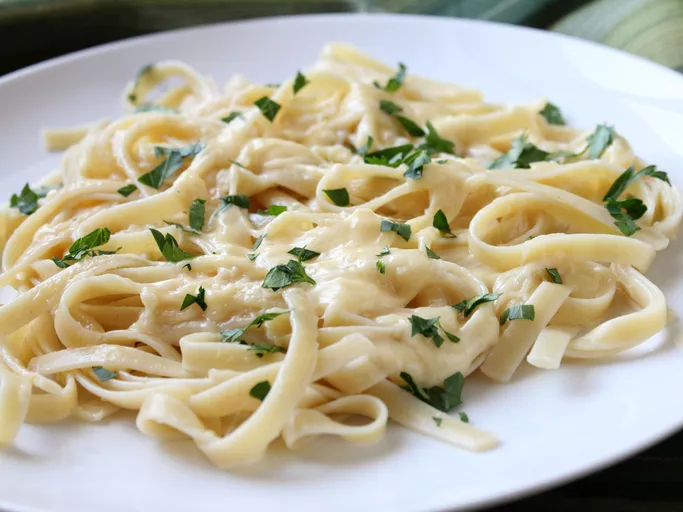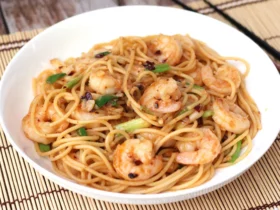What is Alfredo Sauce?
History of Alfredo Sauce
Alfredo sauce, also known as fettuccine alfredo or simply alfredo, is a popular Italian sauce made from just a few key ingredients: butter, cream, Parmesan cheese, and seasonings. It’s a rich, velvety sauce that originates from Rome, Italy, where it was first created in the early 20th century by Italian chef Alfredo Di Lelio.
The story behind Alfredo sauce begins with its namesake, Alfredo Di Lelio, who ran a restaurant called Alfredo’s on the Via della Scrofa in Rome. In the late 1800s and early 1900s, this area of Rome was known for its high-end restaurants catering to wealthy tourists.
According to legend, Di Lelio created his signature sauce as a way to please his wife, who was recovering from childbirth and had lost her appetite. He mixed butter, Parmesan cheese, and eggs together to create a creamy, easy-to-digest sauce that would appeal to her taste buds.
The original recipe consisted of just three ingredients: butter, Parmesan cheese, and pasta cooking water. Di Lelio’s son, Alfredo Di Lelio Jr., would later add heavy cream to the mix to give it a richer, more indulgent flavor. Over time, other variations emerged, incorporating additional ingredients like garlic, nutmeg, or black pepper.
Today, Alfredo sauce is enjoyed worldwide as a comforting, satisfying condiment for pasta dishes, meatballs, and vegetables. Its creamy texture and savory flavors have made it a staple in many Italian restaurants and homes, often served alongside fettuccine noodles to create the classic dish fettuccine alfredo.
Interestingly, Alfredo sauce gained international fame after World War II, when American soldiers stationed in Italy discovered its rich flavor. They brought the recipe back to their home countries, where it quickly became a popular menu item in restaurants and households across North America and beyond.
In recent years, various adaptations of Alfredo sauce have emerged, incorporating healthier ingredients or non-dairy alternatives to cream and cheese. These innovations cater to modern tastes while maintaining the essence of this beloved Italian classic.
The enduring appeal of Alfredo sauce lies in its rich history, versatility, and ability to bring people together around the dinner table. Whether you’re a food enthusiast, an Italian cuisine aficionado, or simply looking for a comforting dish to share with loved ones, Alfredo sauce is sure to delight your taste buds and warm your heart.
A classic Italian sauce originating from Rome, Alfredo was first made in the 1900s by Italian chef Alfredo Di Lelio for his wife.
Alfredo sauce, a beloved and iconic condiment originating from Rome, Italy, has been delighting palates for over a century. The birth of this rich and creamy sauce is attributed to Italian chef Alfredo Di Lelio, who created it in the early 1900s for his wife, Ines.
The story goes that Ines was suffering from what was then believed to be lactose intolerance, but was likely anemia. Chef Di Lelio sought to create a dish that would provide her with much-needed energy while also being gentle on her digestive system.
He experimented with various ingredients and came up with a sauce made from just three main components: butter, Parmesan cheese, and pasta cooking water. The simplicity of the recipe belies the depth of flavor and richness that Alfredo sauce brings to dishes.
The original Alfredo sauce recipe, as created by Chef Di Lelio, was incredibly basic by today’s standards. It consisted solely of melted butter, grated Parmesan cheese, and pasta cooking water, whisked together until smooth and creamy.
This humble beginning would eventually give rise to a global phenomenon. Today, Alfredo sauce is a staple in Italian cuisine, with countless variations and adaptations flooding the market. However, at its core, the essence of this beloved sauce remains unchanged.
Despite its popularity, there’s something undeniably authentic about the original Alfredo sauce recipe that has captured hearts around the world. Perhaps it’s the nostalgic charm of a bygone era, or perhaps it’s simply the unadulterated flavor that speaks to our deepest cravings.
The versatility of Alfredo sauce is one of its most appealing aspects. It can be enjoyed as a standalone dish, tossed with spaghetti for a classic take on fettuccine Alfredo, or used as a base for other sauces and recipes.
Key Ingredients
Alfredo Sauce is a rich and creamy condiment originating from Italy, traditionally served with Spaghetti Fettuccine. This classic sauce is made from just a few key ingredients that combine to create an unparalleled flavor experience.
The fundamental components of Alfredo Sauce are:
- Parmesan Cheese
- Butter
- Freshly ground Black Pepper
- Cream (heavy or half-and-half)
The distinctive taste of Alfredo Sauce stems from the union of these ingredients, which when cooked together create a velvety texture and an intense umami flavor.
In traditional Italian cooking, the preparation of Alfredo Sauce is often associated with the Carbonara sauce, although both dishes have distinct differences in terms of ingredients and preparation methods. While Carbonara features eggs as a primary component, Alfredo relies on cream for its rich texture.
To this day, Alfredo Sauce remains one of the most beloved Italian sauces worldwide, prized not only for its taste but also for its simplicity and versatility in various culinary applications.
Butter, Parmesan cheese, and pasta are essential ingredients found in traditional Alfredo sauce.
The Alfredo sauce, a classic Italian condiment, has been delighting palates for over a century. This rich and creamy sauce originated in Rome, Italy, and its simplicity belies its depth of flavor.
At the heart of Alfredo sauce are three essential ingredients: butter, parmesan cheese, and pasta. These ingredients work together to create a harmonious balance of flavors that will leave you craving more.
Why Butter?
The use of high-quality butter is crucial in Alfredo sauce. It provides a subtle nutty flavor and a smooth, velvety texture that coats the pasta perfectly. You can choose to use either salted or unsalted butter, but it’s essential to note that the choice will affect the overall flavor profile.
The Role of Parmesan Cheese
Parmesan cheese, also known as parmesano reggiano, is the star of the show in Alfredo sauce. This nutty, sharp-tasting cheese adds a salty, savory flavor that elevates the dish to new heights.
The Importance of Pasta
The choice of pasta is crucial when it comes to Alfredo sauce. Traditionally, fettuccine is used as it has a broad flat shape that allows the sauce to coat evenly. However, you can experiment with other types of pasta such as spaghetti or linguine.
How to Make Alfredo Sauce
To make authentic Alfredo sauce, follow these steps:
- Melt butter in a large skillet over medium heat.
- Add grated parmesan cheese and stir until melted and smooth.
- Continue to cook for 1-2 minutes, or until the sauce has thickened slightly.
- Toss cooked pasta with Alfredo sauce and serve immediately.
Enjoy your homemade Alfredo sauce recipe!
Making Alfredo Sauce Recipe
Ingredients Needed
To make an authentic Italian Alfredo sauce recipe, you will need the following ingredients:
Main Ingredients
- 12 tablespoons unsalted butter
- 3 cloves garlic, minced
- 1 cup heavy cream
- 1/2 cup grated Parmesan cheese (freshly shredded is best)
Additional Ingredients
- 1 teaspoon salt
- Freshly ground black pepper, to taste
- 1/4 cup chopped fresh parsley (optional)
You will also need some basic cooking equipment and tools:
Cooking Equipment
- A medium saucepan with a heavy bottom (stainless steel or copper)
- A wooden spoon or silicone spatula
- A hand blender or whisk for mixing the sauce
Important Notes
- Use high-quality Parmesan cheese, as it will give the best flavor to your Alfredo sauce.
- Don’t overheat the butter, or it may separate and lose its richness.
- You can adjust the amount of garlic and pepper to suit your taste preferences.
Remember that this is a basic recipe, and you can always add other ingredients to customize it according to your tastes. Some common variations include adding cooked chicken or seafood, or using different types of cheese.
Butter and Parmesan cheese must be melted together to create the creamy texture of Alfredo sauce.
In order to make a classic Alfred Fettuccine pasta dish, you will need to create a delicious and rich Alfredo sauce. The key ingredient that gives this sauce its creamy texture is the combination of butter and Parmesan cheese melted together.
The process begins with melting 6 tablespoons of unsalted butter in a medium-sized saucepan over low heat. This will help to prevent the butter from burning or separating, which would result in an unappealing texture.
Once the butter has fully melted, add 3/4 cup of freshly grated Parmesan cheese to the pan. It’s essential to use high-quality Parmesan for this recipe, as it will provide a rich and nutty flavor that complements the pasta perfectly.
Continue to stir the mixture constantly until the cheese is fully incorporated into the butter. This may take about 2-3 minutes, depending on the temperature of your stovetop and the type of cheese you’re using.
As the cheese begins to melt, the sauce will start to thicken slightly. Don’t worry if it appears a bit grainy at this point – it’s just the Parmesan starting to break down into smaller particles that will eventually create a smooth consistency.
One of the most important aspects of making Alfredo sauce is to avoid adding any liquid or moisture to the mixture, as this would cause it to separate and lose its creamy texture. This means not adding milk, cream, or even water – only pure butter and Parmesan cheese will do!
Once you’ve achieved a smooth and velvety consistency, remove the sauce from heat and let it cool slightly. This will allow the flavors to meld together and intensify, resulting in an incredibly rich and satisfying taste experience.
The final step is to season the Alfredo sauce with salt to enhance the flavor of the Parmesan cheese and add a touch of savory goodness. Be careful not to over-season – you want to strike a balance between salty and subtle.
Step-by-Step Instructions
The classic Italian sauce that originated in Rome, Italy, and has since become a staple in many restaurants around the world – Alfredo sauce. This rich, creamy, and indulgent sauce is made with just a few simple ingredients, yet it’s packed with flavor. In this article, we’ll take you through a step-by-step guide on how to make the perfect Alfredo sauce recipe at home, along with a video tutorial to help you get it spot on.
Ingredients:
- 12 tablespoons (6 ounces) unsalted butter
- 3 cloves garlic, minced
- 1 cup heavy cream
- 1/2 cup grated Parmesan cheese (freshly shredded is best)
- 1 teaspoon dried basil
- Salt and black pepper to taste
Equipment:
- Large saucepan with a heavy bottom (stainless steel or enameled cast iron)
- Whisk or wooden spoon
- Measuring cups and spoons
- Grater or food processor for Parmesan cheese (optional)
Step 1: Melt the Butter
Melt the butter in a large saucepan over medium heat. Yes, you read that right – 12 tablespoons of butter! This might seem excessive, but trust us; it’s necessary for creating the signature creaminess and richness of Alfredo sauce.
Once melted, let the butter simmer for about 2-3 minutes, until it starts to turn a light golden brown color. Stir occasionally to prevent burning or scorching.
Step 2: Add Garlic
Add the minced garlic and cook for another minute, stirring constantly to prevent burning. You want to infuse the butter with that unmistakable aroma of cooked garlic without overpowering the sauce.
Step 3: Pour in Cream
Pour in the heavy cream and bring the mixture to a gentle simmer. Reduce the heat to low and let it cook for about 2-3 minutes, until the cream has thickened slightly and started to coat the back of a spoon.
Step 4: Add Parmesan Cheese
Add the grated Parmesan cheese and stir until fully incorporated. If using a food processor or grater to shred your own cheese, be sure to grate it immediately before adding it to the sauce to prevent it from clumping.
Step 5: Season with Salt, Pepper, and Basil
Season the sauce with salt, black pepper, and dried basil. Taste and adjust as needed – remember that you can always add more seasoning but it’s harder to remove excess salt or flavorings.
Step 6: Serve and Enjoy!
Congratulations! You’ve made authentic Alfredo sauce at home. This sauce is perfect for tossing with cooked pasta, adding grilled meats, vegetables, or seafood – the possibilities are endless. Store any leftover sauce in an airtight container in the fridge for up to 3 days or freeze it for up to 2 months.
And that’s it! With this simple yet detailed guide and video tutorial, you should be able to whip up delicious Alfredo sauce every time. Practice makes perfect, so don’t be discouraged if your first batch doesn’t turn out exactly as you hoped – keep experimenting until you get the hang of it.
Combine butter, Parmesan, black pepper, and heavy cream in a saucepan, whisking until the mixture thickens.
To make a delicious and authentic Alfredo sauce, you’ll need to combine four main ingredients in a saucepan over medium heat: butter, Parmesan cheese, black pepper, and heavy cream.
First, take 6 tablespoons of unsalted butter and place them in the saucepan. You can use either salted or unsalted butter, but keep in mind that unsalted will bring out more flavor from the other ingredients.
Next, add 1/2 cup of freshly grated Parmesan cheese to the saucepan. This is where the rich, nutty flavor of Alfredo comes from, so be sure to use high-quality Parmesan.
After that, sprinkle a pinch of black pepper over the butter and Parmesan. Don’t overdo it with the pepper – you want just enough to complement the cheese without overpowering it.
Now, pour in 1/2 cup of heavy cream into the saucepan. Heavy cream is essential for creating the smooth, creamy texture that Alfredo sauce is known for.
Once all your ingredients are combined, use a whisk or wooden spoon to mix everything together over medium heat. As you stir, you’ll start to notice the butter and cheese melting together and forming a smooth paste.
Continue cooking the mixture for about 2-3 minutes, or until it thickens slightly and forms a rich, velvety sauce. Be careful not to let it simmer too long, as this can cause the cream to separate and create an uneven texture.
As you whisk the Alfredo sauce, pay attention to its consistency. If you find it’s too thin, continue cooking for another minute or so until it thickens up nicely. Alternatively, if it becomes too thick, add a little more heavy cream to thin it out.
Once your sauce has reached the perfect consistency, remove it from heat and let it cool slightly before using it in your favorite pasta dish. Some popular options include tossing it with fettuccine or spaghetti for an authentic Italian experience!
Tips for Serving Alfredo Sauce
Pairing Options
Serving Alfredo sauce can elevate a simple pasta dish into an Italian-inspired feast. Here are some tips for serving Alfredo sauce and pairing options to make your meal truly special:
Basic Serving Tips
To ensure that the creamy texture of the Alfredo sauce is preserved, it’s essential to heat it gently over low-medium heat.
You can serve the Alfredo sauce straight out of the pot or transfer it to a warm serving dish. Just be sure not to leave it at room temperature for too long, as it will thicken and become difficult to reheat.
Pairing Options
- Fettuccine or Spaghetti: These classic pairings are staples in Italian cuisine. The flat noodles of fettuccine allow the Alfredo sauce to coat each strand evenly, while spaghetti provides a more rustic texture.
- Vegetables: Adding steamed vegetables such as broccoli, zucchini, or bell peppers can provide a nice contrast in texture and flavor to the rich Alfredo sauce.
- Poultry or Seafood: Toss cooked chicken or shrimp with the Alfredo sauce for added protein. This makes for an excellent main course.
Optional Add-ins
If you want to add a bit more excitement to your meal, consider tossing in some of the following ingredients:
- Bacon bits or diced ham: These can be added at the end for a savory flavor boost.
- Grilled chicken or shrimp: For an extra burst of protein and texture.
- Cooked mushrooms: Sliced or chopped, they add an earthy flavor to balance out the creaminess of the Alfredo sauce.
Tips for Serving a Crowd
When serving a large group, consider making the Alfredo sauce ahead and reheating it as needed. You can also serve it from a large serving dish or set up a pasta bar with all the fixings, allowing everyone to create their own perfect combination.
Adding an Italian Touch
To add a touch of Italy to your meal, consider adding some Italian parsley on top of the Alfredo sauce. This will give it a pop of color and fragrance that is quintessentially Italian. You could also serve it with some crusty bread for dipping in the sauce.
Alfredo sauce can be served with various pasta types, such as fettuccine or spaghetti.
The classic Italian sauce, Alfredo, has been a favorite for many years, and its versatility makes it an excellent choice to serve with various types of pasta. When serving Alfredo sauce, there are several tips to keep in mind to ensure that your dish is truly delicious.
Choose the right pasta: While fettuccine is perhaps the most traditional pairing with Alfredo sauce, you can also experiment with other long, flat noodles such as spaghetti or linguine. Shorter shapes like penne or bow-tie pasta work well too, but they may not be as elegant a presentation.
Use high-quality ingredients: The key to a rich and creamy Alfredo sauce lies in the quality of its ingredients, particularly the butter and Parmesan cheese. Make sure you use freshly grated Parmesan and real butter for an authentic flavor.
Temperature control is crucial: To achieve that perfect silky texture, it’s essential to heat the pasta just until it’s al dente, then immediately combine it with the Alfredo sauce. If the pasta sits in the sauce too long or becomes overcooked, the dish may become mushy and unappetizing.
Don’t overdress: When serving Alfredo sauce, less is often more. A light coating of the sauce allows the delicate flavor of the pasta to shine through without overpowering it with richness.
Serve immediately: Alfredo sauce is a time-sensitive dish that’s best served hot and fresh. To maintain its silky texture and flavors, try to serve the dish within 15-20 minutes of preparation.
Consider add-ins: For added flavor and texture, you can introduce ingredients such as cooked chicken, sautéed vegetables, or even seafood like shrimp or scallops into your Alfredo sauce. Just be sure not to overdo it – too many add-ins can disrupt the balance of flavors.
Avoid over-mixing: When combining the pasta with the Alfredo sauce, use a gentle folding motion to distribute the sauce evenly without breaking down the pasta strands. This will ensure that each bite is perfectly coated in the rich and creamy sauce.
Adding Vegetables and Proteins
Serving Alfred Fettuccine with Alfredo sauce, whether it’s store-bought or homemade, requires a few key tips to bring out its rich and creamy flavor. The first step is to cook your fettuccine according to package instructions until al dente, then drain and set aside. This ensures the pasta doesn’t become mushy or overcooked.
Next, warm up your Alfredo sauce in a saucepan over low heat, whisking occasionally to prevent it from separating. Once heated through, remove from heat and toss with cooked fettuccine until well coated.
A great way to add vegetables is by incorporating steamed broccoli florets or sautéed mushrooms into the dish. Simply cook your chosen vegetable according to preference, then toss with the pasta and sauce for added nutrition and flavor.
Adding protein sources like cooked chicken breast or shrimp can elevate the dish even further. Season the protein with herbs and spices before adding it to the fettuccine and sauce for an extra burst of taste.
Consider making a compound Alfredo by mixing in some grated Parmesan cheese, chopped parsley, or lemon zest into the pasta mixture. These flavors will enhance the overall experience without overpowering the original Alfredo sauce.
Finally, garnish with additional herbs like basil or chives for visual appeal and fragrance.
Main Tips
Tip 1
Use high-quality ingredients, including fresh vegetables and proteins, to maximize flavor and texture.
Tip 2
Don’t overcook the pasta – al dente is key for retaining its texture in Alfredo sauce.
Tip 3
Whisk the Alfredo sauce gently while heating it up to prevent separation and maintain its creamy consistency.
Tip 4
Balance the dish with a variety of flavors, such as vegetables and protein sources, to create a well-rounded meal.
Shrimp or vegetables like spinach can also be added to create a more filling Alfredo dish.
When serving Alfredo sauce, it’s essential to have a few tips up your sleeve to ensure that you’re making the most of this rich and creamy sauce. Here are some suggestions for adding protein or vegetables to create a more filling Alfredo dish:
Add Shrimp: One of the most popular additions to Alfredo sauce is shrimp, which pairs perfectly with the creaminess of the sauce. Simply sauté the shrimp in butter until they’re pink and cooked through, then toss them with the Alfredo sauce.
Use Spinach: Adding a handful of fresh spinach leaves to the Alfredo sauce is an excellent way to add some nutrients and color to your dish. Simply wilt the spinach into the sauce by cooking it in butter or using a little bit of heat, then toss with cooked pasta.
Add Other Vegetables: While spinach is a classic addition to Alfredo sauce, you can also experiment with other vegetables such as broccoli, bell peppers, or mushrooms. Simply sauté the vegetables in butter until they’re tender, then add them to the Alfredo sauce.
Use Chicken: If you prefer not to use seafood, chicken is another excellent option for adding protein to your Alfredo dish. Simply cook diced chicken in a pan with some oil and seasoning until it’s cooked through, then toss it with the Alfredo sauce and pasta.
Tips for Serving
Use fresh ingredients: Fresh herbs like parsley or basil add a burst of flavor to your Alfredo dish, so be sure to use them whenever possible.
Serve immediately: Alfredo sauce is best served immediately after it’s been cooked, as the starches in the pasta will help to thicken the sauce. If you’re making this recipe for a crowd, consider setting up a buffet-style station where guests can serve themselves and add their favorite toppings.
Add some acidity: A squeeze of fresh lemon juice or a splash of vinegar can help to cut through the richness of the Alfredo sauce, balancing out the flavors in your dish.
By following these simple tips and experimenting with different ingredients and flavor combinations, you’ll be well on your way to creating a delicious and satisfying Alfredo dish that’s sure to become a favorite in your household!
- Best LeadsGorilla Alternatives for 2025 - April 22, 2025
- Best Leadzai Alternatives for 2025 - April 22, 2025
- Best LeadSwift Alternatives for 2025 - April 21, 2025














